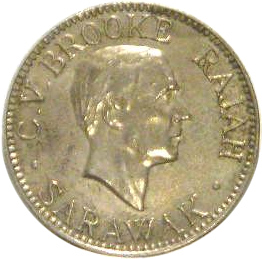Sarawak dollar facts for kids
Quick facts for kids Sarawak dollar |
|
|---|---|
| User(s) | |
| Subunit | |
| 1⁄100 | cent |
| Symbol | $ |
| Coins | 1⁄4, 1⁄2, 1, 5, 10, 20, 50 cents |
| Banknotes | 5, 10, 20, 25, 50 cents, 1, 5, 10, 25, 50, 100 dollars |
The Sarawak dollar was the money used in the Raj of Sarawak from 1858 to 1953. It was divided into 100 smaller parts called cents. This dollar was worth the same as the Straits dollar and later the Malayan dollar. These were the currencies used in Malaya and Singapore.
The Sarawak dollar stayed equal to these other currencies until 1953. At that time, all these currencies were replaced by the Malaya and British Borneo dollar.
During World War II, from 1942 to 1945, Japan took control of Sarawak. During this time, new paper money was printed. These notes came in values from 1 cent up to 1,000 dollars. The Japanese set the value of their Sarawak dollar to be equal to 1 Japanese yen. Before the war, one Sarawak dollar was worth two Japanese yen.
After the war ended, the Japanese money became worthless. The original Sarawak dollar notes and coins became valuable again. They went back to their pre-war value compared to the British pound.
Contents
Coins of Sarawak: A Look at Their History
All the coins from Sarawak showed the face and name of one of the "White Rajahs" of Sarawak. These were the rulers of Sarawak. The first was James Brooke until 1868. Then came Charles Brooke from 1868 to 1917. Finally, Charles Vyner Brooke was on the coins from 1917 until 1938, when this currency stopped being made.
Throughout its history, Sarawak made coins in several values. These included 1⁄4 cent, 1⁄2 cent, 1 cent, 5 cents, 10 cents, 20 cents, and 50 cents.
Smallest Coins: Quarter and Half Cents
The 1⁄4 cent coin was made of copper and was the smallest value. It was also the first coin to stop being made, with its last issue in 1896. The 1⁄2 cent coin was also always made of copper. After being made smaller in size, it was eventually stopped in 1933.
Changes to the 1 Cent Coin
Starting in 1892, some 1 cent coins had a hole in the middle. However, this design with a hole was only used until 1897. In 1920, the 1 cent coin was made from a mix of copper and nickel. But later, in 1927, it went back to being made of bronze.
Silver and Copper-Nickel Coins
The 5 and 10 cent coins were made of 80% silver until 1920. That year, their silver content was briefly lowered to 40%. Soon after, they were replaced with coins made of copper-nickel. The 20 and 50 cent coins continued to be made of silver. However, in 1920, their silver content was also reduced from 80% to 40%.
Banknotes: Paper Money of Sarawak
The very first paper money was printed by the Sarawak Government Treasury. These notes were simple and not very high quality. All the banknotes made after that were issued by the Government of Sarawak. The only exceptions were the 10-cent and 25-cent notes from 1919, which were again issued by the Treasury.
Over time, Sarawak printed banknotes in many different values. These included 5 cents, 10 cents, 20 cents, 25 cents, and 50 cents. Larger values were $1, $5, $10, $25, $50, and $100.
See also


